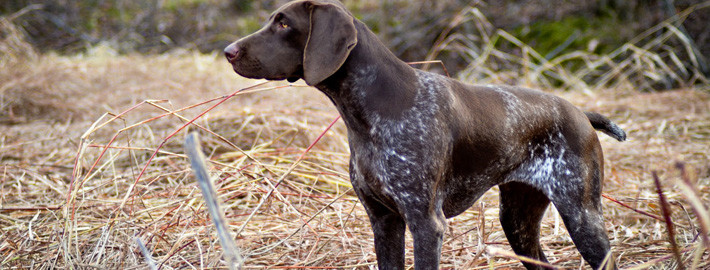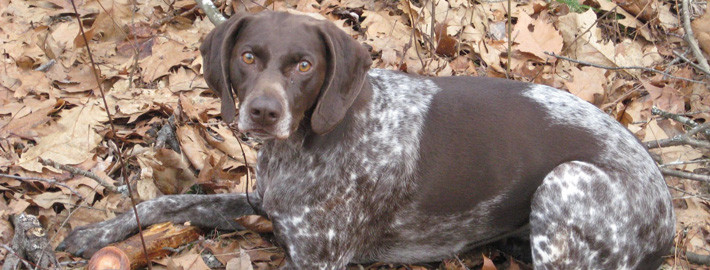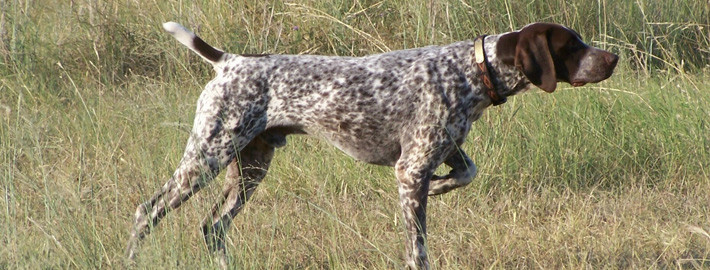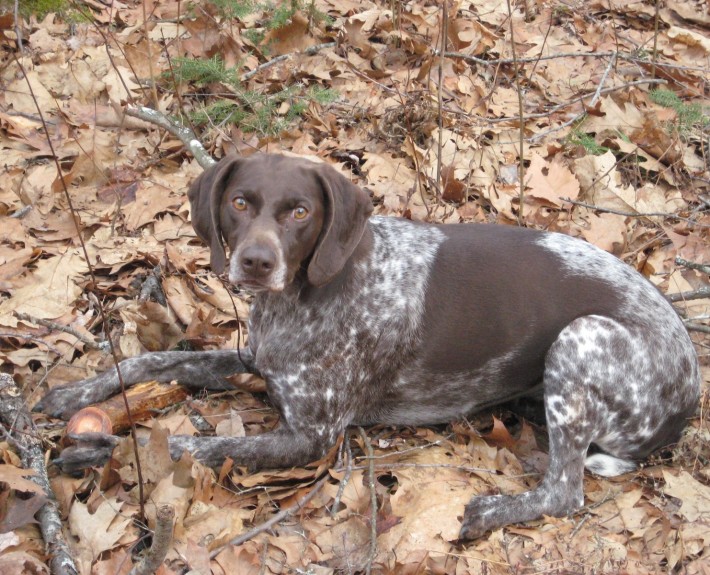What makes the German Shorthaired Pointer Unique?
The shorthaired is an all-purpose close-working gun dog that combines agility, power and endurance. It is square or slightly longer than tall; although it has a short back, it should stand over plenty of ground. It should have a clean-cut head, graceful outline, strong quarters and an athletic physique. The gait is smooth, light and ground-covering. The coat is short and tough. The German shorthaired pointer’s idea of heaven is a day hunting in the field and an evening curled up by its owner’s side. This is an active dog that can become frustrated and “creative” if not given ample daily exercise, both mental and physical. It is a devoted family pet, although at times it is overly boisterous for small children. Because part of its heritage includes hunting mammals, some can be aggressive to small pets unless raised with them. It is a sensitive breed, responsive to gentle training. Some can whine or bark a lot.
Page Contents
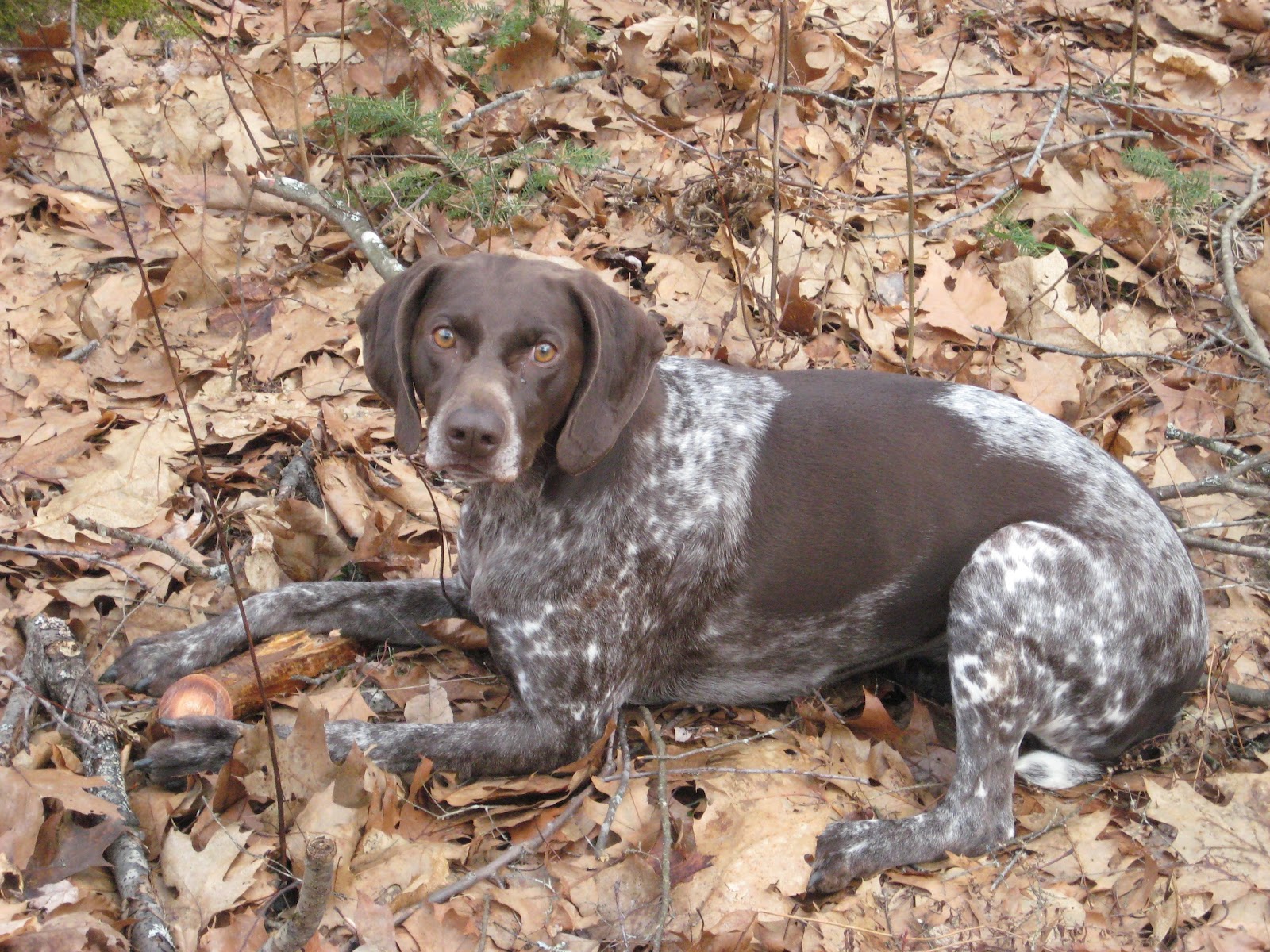
SnapShot
| Size: | Males – 60–70 cm – 25–28 in Females – 58–66 cm 23–26 in |
| Weight: | Males – 25–34kg – 55–75 lb Females – 20–30 kg – 45–65 lb |
| Origin: | Germany |
| Life Span: | 12 to 14 years |
| Colour: | Solid liver, liver and white spotted, liver and white spotted and ticked; liver and white ticked, |
| Litter Size: | 7 to 8 puppies. |
Is the German Shorthaired Pointer Right For You?
Energetic and fun-loving, the breed is very fond of children once a relationship is established. He is a loyal family pet and a good guard dog, the ideal choice for many families. He requires regular exercise and grooming. Learn more purchasing a German Shepherd Dog puppy. Herding Group; AKC recognized in 1908.
Ranging in size from 22 to 26 inches tall at the shoulder.
Herding, police work.
In 5 Words
- Bold
- Cooperative
- Affectionate
- Intelligent
- Trainable
Characteristics
Learn About the German Shorthaired Pointer
Description
The German Shorthaired Pointer is a versatile all-purpose gundog. The head is in proportion to the body. The skull is slightly round on top, broad and arched on the sides. The length of the muzzle should be equal to the length of the skull. The muzzle is long with a slight stop that can be viewed from the side. The large nose is brown with wide open nostrils. The almond-shaped, medium-sized eyes are dark brown. The high-set ears are broad, hanging close to the head. The teeth should meet in a scissors bite. The chest is deep. The tail is docked to about 40% of its length. Note: docking tails is illegal in most parts of Europe. The compact feet are webbed. Dewclaws on the front feet may be removed. The skin is tight. The short coat is thick and rough to the touch. It is slightly longer on the underside of the tail and the back edge of the hips, and softer, shorter and thinner on the head and ears. Coat colors include solid liver, liver and white, liver ticked or patches, white ticked or liver roan.
Short History of the German Shorthaired Pointer
Originally referred to as Deutsch Kurzhaar, the German Shorthaired Pointer is known for its versatile hunting capabilities. In the early 17th century, the Spanish Pointer was crossbred with the Hannover Hound, which produced a dog that was capable of trailing both mammals and birds.
Further breeding with the English Pointer gave rise to controversies among some of the breeders, but eventually the German Shorthaired Pointer was created. The breed first entered the United States in the 1920s, later being recognized by the American Kennel Club in 1930. Today the breed is regarded for its ability to easily point, trail, and retrieve its target.
Temperament
German Shorthaired Pointers are active, responsive, gentle, affectionate, and even-tempered. They are friendly to friends and families, although some strains are timid. They are excellent working dogs, and love more than anything to go out with their master and hunt. They enjoy water or land equally. German Shorthaired Pointers are exuberant at times, with their energy abounding. They get along well with children, and are adaptable to many different kinds of life. They are good natured, sad if you leave, and excited when they know they’ve pleased their master. They are also very alert to their surroundings.
Caring for Your German Shorthaired Pointer
General Health
The German Shorthaired Pointer, which has an average lifespan of 12 to 14 years, is prone to minor health concerns like gastric torsion, hypothyroidism, canine hip dysplasia (CHD), Osteochondrosis Dissecans (OCD), von Willebrand’s Disease (vWD), entropion, and pannus, and major issues such as lymphedema. Other problems that can be occasionally seen in breed include cardiomyopathy, ectropion, and progressive retinal atrophy (PRA). To identify some of these issues, a veterinarian may recommend regular thyroid, hip, cardiac, and eye exams, and tests to verify vWD.
Grooming & Bathing
The smooth coat of the Pointer is very easy to groom. Just brush regularly with a firm bristle brush and bathe only when necessary. A rub with a piece of toweling or chamois will leave the coat gleaming. Check the feet also, especially after the dog has been exercising or working. Dry the dog thoroughly after hunting to prevent chilling. Examine the ears regularly. This breed is an average shedder.
Exercise & Training
German Shorthaired Pointers need plenty of vigorous exercise to keep in shape, and any prospective owners should be aware of this. They may become destructive if bored.
German Shorthaired Pointers love to learn and are very trainable. They should have some form of obedience training. Patient, firm leadership is essential.

